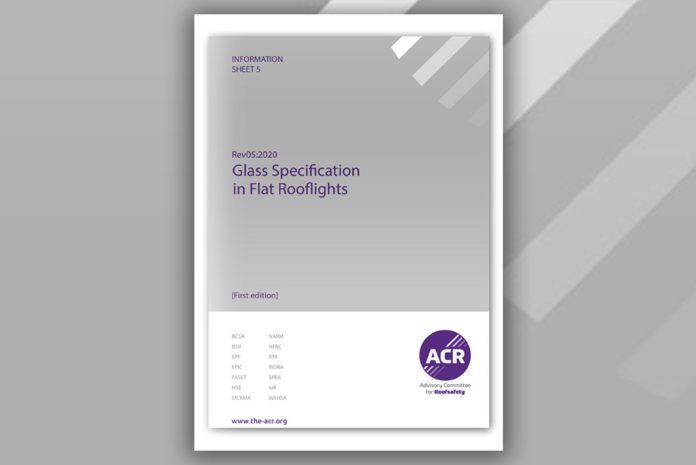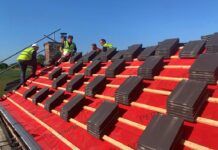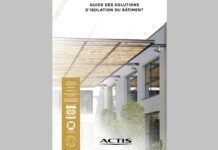The ‘Glass Specification in Flat Rooflights’ document from the Advisory Committee for Roofsafety (ACR), which references data from the National Association of Rooflight Manufacturers (NARM), gives clear guidance on design and glass specification for this type of rooflight.
Mark Wilcox, ACR committee member and safety representative for NARM, pointed out that: “It’s important to note that there are many high quality flat glass rooflights available from reputable suppliers, all of which offer excellent aesthetics and performance. However, there have been a number of cases reported by individuals who have installed or commissioned what they believed to be high quality products, only to discover functional problems and more importantly, major safety concerns, following installation.”
Major concerns outlined in the document are:
- The use of inner panes made of toughened (rather than laminated) glass, which can
shatter under a number of circumstances (including, on occasion, spontaneously), falling into the room beneath. - The use of glass specifications which may be appropriate for use in vertical glazing, but are unsuitable for use in overhead glazing where glass can be almost horizontal, significantly increasing the stress on the pane.
- Insufficient support for the inner glass pane, potentially allowing a whole glazed unit to fall into the room beneath if the outer pane is broken, jeopardizing both safety and security. Some recently reported designs consist of nothing more than a double-glazed unit stepped on all four sides with no perimeter frame, with the outer pane sealed/bonded to the top of an upstand and the inner pane hanging inside the upstand. Such designs are not recommended.
Potential dangers
Poor designs or use of incorrect materials in rooflights of this type, bring significant risks to building occupants and personnel accessing roof areas for maintenance or other purposes.
In the case of building occupants, toughened glass inner panes present a clear hazard. The term ‘toughened’ implies a level of safety to the uninitiated. However, whilst toughened glass breaks into rounded fragments rather than razor sharp shards, there are still a number of factors that can cause toughened glass to shatter. These include impacts on the glass; inclusions introduced in the manufacturing process which can cause glass to break if overstressed; and nickel sulphide in the glass, which although rare, can cause toughened glass to shatter spontaneously. All of these factors can result in building occupants being exposed to danger from falling glass fragments: a risk that can be completely eliminated if a laminated glass inner pane is used.
Safety for maintenance staff and others needing to access roof areas, is also greatly compromised by inappropriate rooflight specification. In addition to using a laminated inner pane to protect building users, rooflights can also be specified and designed to be non-fragile in accordance with ACR[M]001 The Red Book – Test for Non-Fragility of Large Element Roofing Assemblies, and CWCT TN66 Safety and Fragility of Glazed Roofing: Guidance on Specification. This is intended to ensure that anyone accidentally walking or falling onto a rooflight will not fall through it, even if it results in the glass being broken or the rooflight being damaged.*
The Advisory Committee for Roofsafety (previously known as the Advisory Committee for Roof Work) is a body dedicated to making working on roofs safer. Established in 1998 from a working group, it was originally set up by invitation of the Health and Safety Executive to look at the issue of fragility of roofing assemblies.
This latest ACR document contains information on the relevant British Standards pertaining to glass rooflight specification, including reference to security compliance. It can be downloaded free of charge from the ACR website at: https://www.the-acr.org/publications/.
The wide range of other roof-safety related documents published by ACR can also be downloaded here, including: The Red Book ACR(M)001-2019 [Sixth edition] – Test for Non-Fragility of Large Element Roofing Assemblies; The Orange Book ACR[CP]001: 2016 Rev 5 Recommended Practice for work on Profiled Sheeted Roofs; and many others.
* It is important to note that the term ‘non-fragile’ can be applied to a wide range of rooflight types offering varying degrees of durability and impact resistance. A non-fragile rooflight is not designed to be walked upon, and the term should not be confused with rooflights which are specifically designed for foot traffic. These ‘walk-on’ rooflights are very high specification glass structures designed to floor loadings and installed in-plane with external floors on roof decks and roof terraces where pedestrian access is unrestricted.




